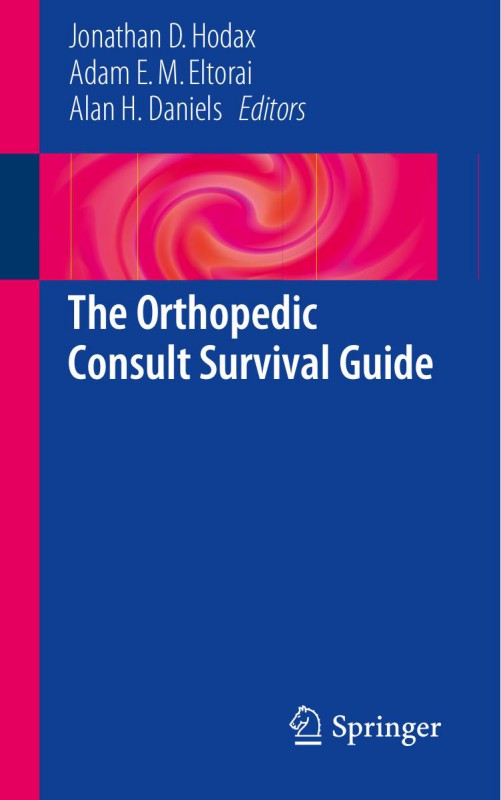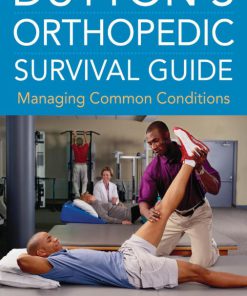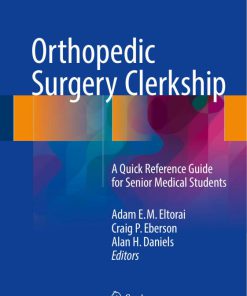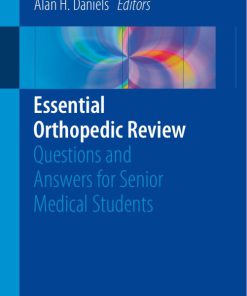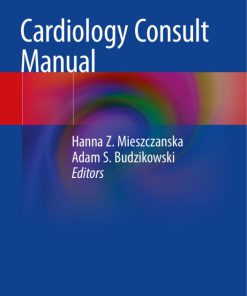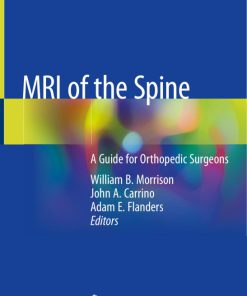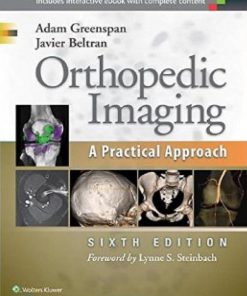The Orthopedic Consult Survival Guide 1st Edition by Jonathan Hodax, Adam Eltorai, Alan Daniels ISBN 9783319523477 3319523473
$50.00 Original price was: $50.00.$25.00Current price is: $25.00.
Authors:Jonathan D. Hodax , Series:Surgery [58] , Tags:Rheumatology; Sports Medicine; Emergency Medicine , Author sort:Hodax, Jonathan D. , Languages:Languages:eng , Published:Published:Mar 2017 , Publisher:Springer , Comments:Comments:This is a quick-reference resource covering the most common acute orthopedic injuries. Including bulleted text and easy-to-follow algorithms, protocols, and images, this “pocket consultant†provides the most up-to-date information when you need it most. Organized anatomically for fast reference, each chapter is broken down into the most common and most serious injuries with tips on how to evaluate and treat adult and pediatric patients. Each injury pattern discussed includes a brief description covering what to ask, what to bring, what to request, what to test, what to look for, and how to further evaluate. The contributing authors are senior orthopedic surgery residents at a major Level-1 Trauma Center who have experience managing a high volume of orthopedic injuries and who have trained many young residents.
The Orthopedic Consult Survival Guide 1st Edition by Jonathan Hodax, Adam Eltorai, Alan Daniels – Ebook PDF Instant Download/Delivery. 9783319523477 ,3319523473
Full download The Orthopedic Consult Survival Guide 1st Edition after payment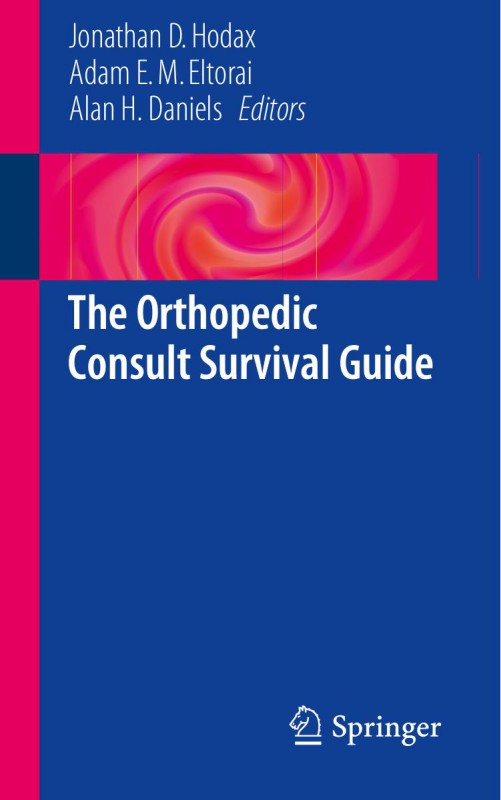
Product details:
ISBN 10: 3319523473
ISBN 13: 9783319523477
Author: Jonathan Hodax, Adam Eltorai, Alan Daniels
The Orthopedic Consult Survival Guide 1st Edition Table of contents:
Part I: Special Considerations in Orthopedics
Chapter 1: The Polytrauma Patient
Overview
Evaluation
When to Escalate
Key Exam Pearls
Effective Communication
Follow-Up
Chapter 2: Open Fractures
Overview
Evaluation
Antibiosis
When to Escalate
Key Exam Pearls
What to Bring
Reduction
Effective Communication
Follow-Up
Chapter 3: High-Energy Trauma
Overview
Evaluation
When to Escalate
Key Exam Pearls
Effective Communication
Follow-Up
Chapter 4: Penetrating Trauma
Overview
Evaluation
Antibiosis
When to Escalate
Key Exam Pearls
What to Bring
When to Get the Bullet
Neurologic Deficits and Stab Injuries
Effective Communication
Follow-Up
Chapter 5: Never-Miss Conditions
Overview
Open Fractures
Compartment Syndrome
Scapulothoracic Dissociation and Traumatic Internal Hemipelvectomy
Septic Arthritis
Specific Dislocations
Cauda Equina Syndrome
The Injury That You Can Make Worse
Part II: Skills and Techniques for Diagnosing and Treating Musculoskeletal Injuries
Chapter 6: Splinting and Casting Techniques
Overview
Upper Extremity Splinting Techniques
Sugar Tong Splint
Volar Splint
Posterior/Ulnar Long-Arm Splint
Thumb Spica Splint
Intrinsic Plus Splint
Coaptation Splint
Short-Arm Cast
Long-Arm Cast
Lower Extremity Splinting Techniques
Posterior Short Leg Splint
Posterior Short Leg with Side Gussets
Posterior Long Leg Splint
Knee Immobilizer
Short Leg Cast
Long Leg Cast
Chapter 7: Joint Aspiration and Injection
Overview
Equipment
Technique
Chapter 8: Hematoma Block
Overview
Equipment
Technique
Chapter 9: Basic Fracture Reduction Principles
Overview
Limit the Patient’s Ability to Counteract Your Efforts
“Just Pulling on It” Is Not Always the Answer
Fatigue, Recreate, and Reduce
You Can’t Win ‘Em All
Chapter 10: Traction Pin Placement
Overview
Indications
What to Ask
What to Request or Bring
Equipment
When to Escalate
Imaging
Effective Communication
Key Procedure Pearls
Technique
Adequate Reduction Parameters
Follow-Up
Part III: Upper Extremity Injuries
Chapter 11: Soft Tissue Injuries of the Hand
Overview
What to Ask
What to Request
When to Escalate
Imaging
Effective Communication
What to Bring
Key Exam Pearls
Interventions and Procedures
Infection
Tendon Injury
Nerve Injury
Artery Injury
Burn/Frostbite
Follow-Up
Chapter 12: Adult Digital and Metacarpal Injuries
Overview
What to Ask
What to Request
When to Escalate
Imaging
Effective Communication
What to Bring
Key Exam Pearls
Reduction/Procedures
Metacarpal Fractures
Interphalangeal Dislocations
Amputations
Nail Bed Injuries
Follow-Up
Chapter 13: Pediatric Digital and Metacarpal Injuries
Overview
What to Ask
What to Request
When to Escalate
Imaging
Effective Communication
What to Bring
Key Exam Pearls
Reduction [1]
Adequate Reduction Parameters [1]
Follow-Up
Reference
Chapter 14: Adult Carpal Injuries
Overview
What to Ask
What to Request
When to Escalate
Imaging
Effective Communication
What to Bring
Key Exam Pearls
Reduction
Scaphoid, Triquetrum, and Hamate Injuries (See Fig. 14.1)
Perilunate Injuries (See Fig. 14.2)
Follow-Up
Chapter 15: Adult Distal Radius Fractures
Overview
What to Ask
What to Request
When to Escalate
Imaging
Effective Communication
What to Bring
Key Exam Pearls
Reduction
Adequate Reduction Parameters
Follow-Up
Chapter 16: Pediatric Wrist and Scaphoid Fractures
Overview
What to Ask
What to Request
When to Escalate
Imaging
Effective Communication
What to Bring
Key Exam Pearls
Reduction [1]
Adequate Reduction Parameters [1]
Follow-Up
Reference
Chapter 17: Adult Forearm Fractures
Overview
What to Ask
What to Request
When to Escalate
Imaging
Effective Communication
What to Bring
Key Exam Pearls
Reduction
Follow-Up
Chapter 18: Pediatric Forearm Fractures
Overview
What to Ask
What to Request
When to Escalate
Imaging
Effective Communication
What to Bring
Key Exam Pearls
Reduction [1]
Adequate Reduction Parameters [1]
Follow-Up
Reference
Chapter 19: Elbow Dislocations
Overview
What to Ask
What to Request
When to Escalate
Imaging
Effective Communication
What to Bring
Key Exam Pearls
Reduction
Follow-Up
Chapter 20: Pediatric Elbow Fractures
Overview
What to Ask
What to Request
When to Escalate
Imaging
Effective Communication
What to Bring
Key Exam Pearls
Reduction [1]
Adequate Reduction Parameters [1]
Follow-Up
Reference
Chapter 21: Humerus Fractures
Overview
What to Ask
What to Request
When to Escalate
Imaging
Effective Communication
What to Bring
Key Exam Pearls
Reduction
Adequate Reduction Parameters
Follow-Up
Chapter 22: Glenohumeral Dislocation
Overview
What to Ask
What to Request
When to Escalate
Imaging
Effective Communication
What to Bring
Key Exam Pearls
Reduction
Follow-Up
Chapter 23: Pediatric Shoulder Injuries
Overview
What to Ask
What to Request
When to Escalate
Imaging
Effective Communication
What to Bring
Key Exam Pearls
Reduction (Depends on Age) [1]
Adequate Reduction Parameters [1]
Follow-Up
Reference
Chapter 24: Clavicle Fractures and Dissociations
Overview
What to Ask
What to Request
When to Escalate
Imaging
Effective Communication
What to Bring
Key Exam Pearls
Reduction (Depends on Age)
Adequate Reduction Parameters
Follow-Up
Part IV: Axial Skeletal Injuries
Chapter 25: Cervical Spine Trauma
Overview
What to Ask
What to Request
When to Escalate
Imaging
Effective Communication
What to Bring
Key Exam Pearls
Injuries
Occipital Condyle
C1 (Atlas) Fractures
C2 (Axis) Fractures
Cervical Facet Dislocations
Follow-Up
Chapter 26: Cervical Stenosis and Central Cord Syndrome
Overview
What to Ask
What to Request
When to Escalate
Imaging
Effective Communication
Key Exam Pearls
Pathology
Follow-Up
Chapter 27: Thoracolumbar Spine Trauma
Overview
What to Ask
What to Request
When to Escalate
Imaging
Effective Communication
Key Exam Pearls
Injuries
Follow-Up
Chapter 28: Lumbar Stenosis and Cauda Equina Syndrome
Overview
What to Ask
What to Request
When to Escalate
Imaging
Effective Communication
Key Exam Pearls
Pathology
Follow-Up
Chapter 29: Spinal Epidural Abscess
Overview
What to Ask
What to Request
When to Escalate
Imaging
Effective Communication
Key Exam Pearls
Pathology
Follow-Up
Chapter 30: Sacral Fractures
Overview
What to Ask
What to Request
When to Escalate
Imaging
Effective Communication
What to Bring
Key Exam Pearls
Follow-Up
Chapter 31: Anterior-Posterior Pelvic Fractures
Overview
What to Ask
What to Request
When to Escalate
Imaging
Effective Communication
What to Bring
Key Exam Pearls
Reduction
Adequate Reduction Parameters
Follow-Up
Chapter 32: Lateral Compression Pelvic Fractures
Overview
What to Ask
What to Request
When to Escalate
Imaging
Effective Communication
Key Exam Pearls
Reduction
Follow-Up
Chapter 33: Vertical Shear Pelvic Injuries
Overview
What to Ask
What to Request
When to Escalate
Imaging
Effective Communication
What to Bring
Key Exam Pearls
Reduction
Adequate Reduction Parameters
Follow-Up
Chapter 34: Pubic Rami Fractures
Overview
What to Ask
What to Request
When to Escalate
Imaging
Effective Communication
Key Exam Pearls
Follow-Up
Chapter 35: Acetabular Fractures
Overview
What to Ask
What to Request
When to Escalate
Imaging
Effective Communication
What to Bring
Key Exam Pearls
Reduction
Adequate Reduction Parameters
Follow-Up
Part V: Lower Extremity Injuries
Chapter 36: Hip Dislocation
Overview
What to Ask
What to Request
When to Escalate
Imaging
Effective Communication
What to Bring
Key Exam Pearls
Reduction
Adequate Reduction Parameters
Follow-Up
Chapter 37: Femoral Head and Neck Fractures in the Young Patient (<65)
Overview
What to Ask
What to Request
When to Escalate
Imaging
Effective Communication
Key Exam Pearls
Reduction
Follow-Up
Chapter 38: Intertrochanteric, Basicervical, and Femoral Neck Fracture in the Geriatric Patient
Overview
What to Ask
What to Request
When to Escalate
Imaging
Effective Communication
What to Bring
Key Exam Pearls
Adequate Reduction Parameters
Follow-Up
Chapter 39: Subtrochanteric Femur Fractures (Proximal 5 cm of Femoral Shaft)
Overview
What to Ask
What to Request
When to Escalate
Imaging
Effective Communication
What to Bring
Key Exam Pearls
Reduction
Adequate Reduction Parameters
Follow-Up
Chapter 40: Adult Femoral Shaft Fractures
Overview
What to Ask
What to Request
When to Escalate
Imaging
Effective Communication
What to Bring
Key Exam Pearls
Reduction
Adequate Reduction Parameters
Follow-Up
Chapter 41: Pediatric Femur Fractures
Overview
What to Ask
What to Request
When to Escalate
Imaging
Effective Communication
What to Bring
Key Exam Pearls
Reduction
Adequate Reduction Parameters
Follow-Up
Chapter 42: Distal Femur Fractures
Overview
What to Ask
What to Request
When to Escalate
Imaging
Effective Communication
What to Bring
Key Exam Pearls
Reduction
Adequate Reduction Parameters
Follow-Up
Chapter 43: Patellar Dislocation
Overview
What to Ask
What to Request
When to Escalate
Imaging
Effective Communication
What to Bring
Key Exam Pearls
Reduction/Treatment
Follow-Up
Chapter 44: Ligament Injuries of the Knee
Overview
What to Ask
What to Request
When to Escalate
Imaging
Effective Communication
What to Bring
Key Exam Pearls
Reduction/Treatment
Follow-Up
Chapter 45: Patellar Fractures and Extensor Mechanism Injuries
Overview
What to Ask
What to Request
When to Escalate
Imaging
Effective Communication
What to Bring
Key Exam Pearls
Reduction/Treatment
Follow-Up
Chapter 46: Tibial Plateau Fractures
Overview
What to Ask
What to Request
When to Escalate
Imaging
Effective Communication
What to Bring
Key Exam Pearls
Reduction/Treatment
Follow-Up
Chapter 47: Adult Tibial Shaft Fractures
Overview
What to Ask
What to Request
When to Escalate
Imaging
Effective Communication
What to Bring
Key Exam Pearls
Reduction/Treatment
Adequate Reduction Parameters
Follow-Up
Chapter 48: Pediatric Tibial Shaft Fractures
Overview
What to Ask
What to Request
When to Escalate
Imaging
Effective Communication
What to Bring
Key Exam Pearls
Reduction/Treatment
Adequate Reduction Parameters
Follow-Up
Chapter 49: Pilon (Axial Load) Ankle Fractures
Overview
What to Ask
What to Request
When to Escalate
Imaging
Effective Communication
What to Bring
Key Exam Pearls
Reduction
Adequate Reduction Parameters
Follow-Up
Chapter 50: Rotational Ankle Fractures
Overview
What to Ask
What to Request
When to Escalate
Imaging
Effective Communication
What to Bring
Key Exam Pearls
Reduction
Adequate Reduction Parameters
Follow-Up
Chapter 51: Pediatric Ankle Fractures
Overview
What to Ask
What to Request
When to Escalate
Imaging
Effective Communication
What to Bring
Key Exam Pearls
Reduction/Treatment
Adequate Reduction Parameters
Follow-Up
Chapter 52: Injuries of the Hindfoot
Overview
What to Ask
What to Request
What to Bring
When to Escalate
Imaging
Effective Communication
Key Exam Pearls
Hindfoot Injuries in Detail
Talus Fractures
Subtalar Dislocations
Calcaneus Fractures
Achilles Rupture
Chapter 53: Injuries of the Midfoot
Overview
What to Ask
What to Request
When to Escalate
Imaging
Effective Communication
What to Bring
Key Exam Pearls
Injuries
Lisfranc Injuries
Navicular Fractures
Navicular Dislocation
Cuboid Fractures
Crush Injuries
In General
Follow-Up
Chapter 54: Injuries to the Forefoot
Overview
What to Ask
What to Request
When to Escalate
Imaging
Effective Communication
What to Bring
Key Exam Pearls
Injuries
Index
People also search for The Orthopedic Consult Survival Guide 1st Edition:
orthopedic surgery consultation
the orthopedic surgery center
an orthopedic surgeon
beyond the scope orthopaedics and sports medicine
You may also like…
eBook PDF
Orthopedic Imaging A Practical Approach 6th Edition by Adam Greenspan ISBN 1451191308 9781451191301

